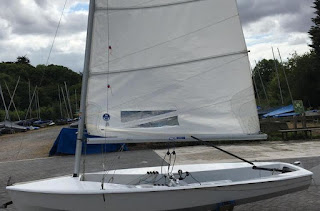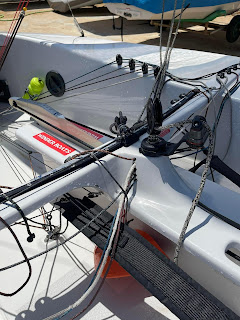Mast Rake Confusion
When I got my Solo I was not sure how to adjust the shrouds and forestay to get the mast set up correctly for racing.
The Usual Advice on the mast step position...
I read the North tuning guide and North Sails suggest:
"Measuring from the front edge of the mast foot to the outside edge of the transom should be as close to 3065mm as possible."
Looking at my setup, that is the mast position that is one back from the furthest forward I could get it in the mast step track on the floor of the boat. To be fair, there are really only 3 possible positions and this is the middle one.
Looking at the mast in this position it still looked a bit odd. It seems to make more sense - to me at least - to put the mast roughly upright and then position it in the mast gate - after all I can't change where the mast gate is. In the middle/recommended position the mast is too far forward in the gate. I want it to be at the back of the gate - there I can allow the mast to bend as I go upwind or I can use chocks if I want to stop it bending too much.
So I ended up in position 3 - the rear-most option the mast step track offered (without radically changing all the rigging that uses the back of the mast step track as an anchor point). Probably at 3050mm from the outer transom, though I need to re-measure this.
The second bit of advice was about forestay tension...
"Set the forestay so its tight when the back of the mast hits the back of the mast gate, then release the forestay tension by 2 holes on the adjuster, this is the base rake."
Again, I had doubts about this straightaway.
On the plus side reducing the forestay tension does let the mast bend more if that is what you need. But there is a limit to how useful this is when you have a fully-battened sail - the sail just isn't very flexible.
On the negative side it moves the centre of effort backwards and downwards. Unless the boat is really designed for this (like a Contender is, for example), you are likely to get weather helm, making the boat difficult to control upwind and increasing rudder drag. You also lower the height of the boom, making it difficult to get under when you tack or gybe.
The guide goes on to suggest that the shrouds should be eased so that the mast can go forward to 5mm to 10mm from the front of the mast gate (P&B suggest it should be almost touching). That strikes me as very loose.Very loose forestay = over-bending the mast?
When you pull in the mainsheet or pull on the kicker, the mast is pushed/bent forwards by the boom. The more you let off the forestay, the further the mast can bend before it is stopped by the front of the mast gate (or a mast chock, if you are using one of those). So what you are doing by making the forestay more loose is bending the mast. This flattens the lower/middle of the sail. But I am not sure this is what you want to do.
Solo sails are all cut with a small amount of luff curve - unlike a Laser which has a large amount of luff curve to cope with the very bendy unstayed mast. Bending any mast upwind is supposed to give you a finer luff entry which helps you point, but from what I can see Solo sails already have this fine entry (due to the full width batten design and stronger masts). So I don't think a lot of mast bend helps. And it could produce a very odd shaped sail on the beats.
Bending the mast is useful to some extent upwind, but if you are over-powered it would be better to buy a flatter sail or apply more cunningham rather than over-bend the mast. So I am doubtful you really need a very loose forestay.
So What Then?
The way I set up my Solo is to start with the mast roughly upright and at the back of the mast gate with all controls off and no chocks. I set the shrouds so that the mast would go forward to about the middle of the gate and I set the forestay so the mast can go back so it almost touches the back of the gate if you push gently.
When you apply a bit of kicker you can see where the mast is bending and add chock(s) to stop the mast bending until it suits your sail and you might change this a little for different wind strengths.
Some two-man dinghies like the Lark/RS200 have very tight rigging - sometimes tensioned with pulley systems or levers - this bends the mast such that you need spreaders set up correctly to stop too much bend. As the Solo mast doesn't have spreaders, tight rig tension just pre-bends the mast a lot, which is unhelpful.
I currently use chocks at front and back of the mast. I made my own chocks out of the industrial plastic Acetal which you can buy in various thicknesses on eBay and cut easily with DIY tools. Using a 2mm thick chock at the back of the mast (as in the photo) is optional, but it protects the gate when controls are off. It doesn't make any difference to performance.
I made various thicknesses of chock so I could choose the right one: 8mm, 6mm, 4mm and 2mm. At present I am using the 4mm at the front which allows the mast to bend a "medium" amount upwind - this seems to suit my sail.
Less Chocking In Windy Weather?
I am not sure. I don't change the chocks according to the wind strength. What I have learnt so far is that you should put on a lot of cunningham tension if you are over-powered upwind. I added an extra purchase to my cunningham pulley system to make this easier and it seems to do the trick. With that and Kirby Sheeting windy weather is a bit easier to handle.
PS Just a footnote - interesting quote in Yachts & Yachting from the new Endeavour Champion of Champions winner, Tom Morris, about mast rake:
"Talking about the boat set-up, Morris added: "Because we are a heavier crew, we needed to keep as much power on as possible by using a bit less kicker than normal, a bit more mainsheet tension, and by not raking the mast back."




Comments
Post a Comment